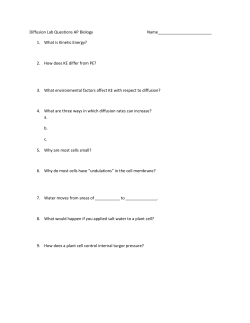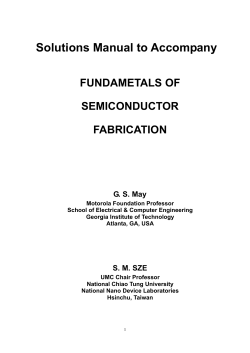
SAMPLE QUESTIONS
SAMPLE QUESTIONS 1. What are the factors that make Si the most attractive material in electronic device applications? List all of them. 2. (a) Describe with all steps how electronic grade polycrystalline Si is prepared from quartzite (SiO2). (b) Briefly describe the Czochralski method of Si crystal growth using a suitable diagram. (c) What do you mean by liquid encapsulated Czochralski technique? (d) A Si ingot, which should contain 1016 boron atoms/cm3, is to be grown by the Czochralski technique. (i) What concentration of boron atoms should be in the melt to give the required concentration in the ingot? (ii) If the initial load of Si in the crucible is 60 kg, how many grams of boron (atomic weight 10.8) should be added? The density of molten Si is 2.53 gm/cm3. The segregation coefficient for boron is 0.8. 3. (a) Draw a neat sketch to describe the Bridgman technique for growing single-crystal GaAs using a two-zone furnace. (b) Show the temperature profile of the said furnace. 4. (a) List four main advantages of wide bandgap semiconductors? (b) What donor and acceptor impurities are preferred in Si and why? 5. What is gettering? What are its beneficial effects? What do you mean by denuded zone? 6. (a) What is the difference between dry oxidation and wet oxidation? (b) Why a small concentration of halogen is used with dry molecular oxygen for thermal oxidation? (c) What is the significance of parabolic rate constant and liner rate constant? (d) Name three techniques using which the thickness of an oxide layer can be determined. (e) If a silicon oxide layer of thickness t is grown by thermal oxidation, what is the thickness of silicon being consumed? (Given, the molecular weight of Si is 28.9 g/mol, and density of Si is 2.33 g/cm3. The corresponding values of SiO2 are 60.08 g/mol and 2.21 g/cm3). (f) A p-type <100> -oriented, silicon wafer with a resistivity of 10 -cm is placed in a wet oxidation system to grow a field oxide of 0.45 m at 1050 0C. Determine the time required to grow the oxide. 7. Differentiate between “Diffusion” and “Ion implantation” of impurity doping. Mention the corresponding merits and demerits. 8. Explain in brief: (i) Electron effective mass is different from its rest mass. (ii) State Einstein relation which relates diffusivity and mobility. (iii) Why four-probe method is superior to two-probe method in determining resistivity of a semiconducting material? (iv) Why is a seed crystal used for crystal growth? (v) Draw a labeled band diagram of a quantum well (where the charge carrier motion is allowed in two dimensions only). 1 9. (a) What is meant by an ohmic contact? (b) What are the conditions that a metalsemiconductor junction will be ohmic in nature? (c) Explain with a suitable band diagram a Schottky contact between a metal and a semiconductor in equilibrium. (d) A metal, with a work function m = 4.2 V, is deposited on an n-type silicon sample with affinity = 4.0 V and Eg = 1.12 eV. What is the potential barrier height seen by electrons in the metal moving into semiconductor? 10. (a) Mention one application for each of the following semiconductors: (i) ZnS, (ii) GaN, (iii) HgxCd1-xTe, and (iv) a-Si. (b) Calculate the primary wavelength of photons emitted from InP (Eg = 1.34 eV) as a result of electron-hole recombination. Will this be visible? 11. (c) Will a silicon photodetector be sensitive to the radiation from a GaAs laser? Why? (d) Find the room temperature resistivity of an n-type silicon sample doped with 1016 phosphorous atoms/cm3. (Given, electron mobility = 1300 cm2/V-s). 12. (a) Draw a neat diagram of a Molecular Beam Epitaxy (MBE) system. (b) Why very high vacuum is required for MBE? 13. Answer in brief: (a) Why as-grown ZnO is always n-type? (b) Does silicon or silicon dioxide have a higher melting point? Why? (c) Show that E.k relationship of a semiconductor is parabolic in nature. (d) What do you mean by compensation in semiconductors? (e) How GaP, in spite of being an indirect bandgap material, is used for the fabrication of LEDs of different colours? (f) Why the electrical resistivity of pure metal increases with temperature? (g) Mention two windows for fiber optic communications where there is lowest attenuation. 14. (a) How a real crystal differs from an ideal crystal? Explain various defects in a bulk semiconducting crystal. (b) The energy of vacancy formation in the germanium crystal is about 2.2 eV. Calculate the fractional concentration of vacancies in Ge at 938 0C, just below its melting temperature. What is the vacancy concentration given that the atomic mass and density of Ge are 72.64 g/mole and 5.32 g/cm3, respectively? (Neglect the change in the density with temperature which is small). 15. (a) Write down the different conditions for the deposition (CVD) of silicon dioxide using (i) silane (SiH4), (ii) TEOS (Si(OC2H5)4) and (iii) dichlorosilane (SiCl2H2). (b) Discuss how the properties of SiO2 films grown from these sources differ from that grown by thermal oxidation. 16. (a) Explain (i) Intrinsic, and (ii) Extrinsic diffusion. (b) Why diffusion profile exhibits anomalous behavior for the diffusion of phosphorus in silicon? (c) Briefly mention how diffusion profiles can be measured using the capacitance-voltage technique? 17. (a) What do you mean by a Class 100 clean room? (b) What do you mean by a Class 100 clean room? (b) If we expose a 200-mm wafer for 1 minute to an air stream under a laminar-flow condition at 30 m/min, how many dust particles will land on the wafer in a class 10 clean room? (Given, for a Class 10 clean room, there are 350 particles, of size 0.5 m, per cubic meter). (c) What is contact 2 printing and proximity printing? What is projection printing? Mention its advantage over shadow printing. (d) How the masks used for IC manufacturing are made of? (e) What is positive photoresist and negative photoresist? 18. (a) Why dielectric films are used in integrated circuits? (b) Explain with examples and justification the role of (i) low dielectric constant (low-k) and (ii) high-k in IC technology. (c) The dielectric constants of SiO2, Si3N4, and Ta2O5 are about 3.9, 7.6, and 25, respectively. What is the capacitance ratio for the capacitors with the Ta2O5 and oxide/nitride/oxide dielectrics for the same dielectric thickness provided the oxide/nitride/oxide has thickness ratio 1:1:1 for the oxide to nitride? (d) How silicon nitride is grown? Explain with a suitable process. (e) In a plasma deposited silicon nitride that contains 20 at% hydrogen and has a silicon to nitrogen ratio (Si/N) of 1.2, find x and y in the empirical formula SiNxHy. 19. (a) How metallization is done in semiconductor industry, particularly for the following metals: (i) Al, (ii) W, and (iii) TiN. (b) Explain (i) junction spiking, and (ii) Electromigration in relation to Al metallization. (c) How aluminum spiking is minimized and its electromigration resistance can be increased? (d) A dielectric material is placed between the two parallel metal lines. The length L = 1 cm, width W = 0.28 m, thickness T = 0.3 m, and spacing S = 0.36 m. Calculate the RC time delay in the following two cases: (i) The metal is Al with a resistivity of 2.67 -cm and the dielectric is oxide with dielectric constant 3.9. (ii) The metal is Cu with resistivity of 1.7 -cm and the dielectric is organic polymer with dielectric constant 2.8. Compare the results in (i) and (ii) and comment. 20. (a) What is the difference between a positive photoresist and a negative photoresist? Draw a typical exposure response curve for a positive photoresist and define the contrast ratio. (b) What type of photoresist is used in deep UV lithography? (c) Explain the steps to transfer IC patterns from a mask to a silicon wafer that has an insulating SiO2 layer formed on its surface. 21. (a) Mention three techniques using which semiconductor can be oxidized. Among these methods which one is the most important for silicon devices? (b) Draw a neat sketch of an oxidation furnace. Mention the ambience for silicon. (c) What is the structural difference between (i) quartz crystal lattice and (ii) amorphous structure of silicon dioxide? Explain schematically by two-dimensional representation. Hence comment on the lower density and impurity diffusion in the later (i.e. structure ii above). (d) Prove that to grow a silicon dioxide layer of 100 nm, a layer of 44 nm of silicon is consumed. (Given, the molecular weight of Si is 28.9 g/mol, and density of Si is 2.33 g/cm3. The corresponding values of SiO2 are 60.08 g/mol and 2.21 g/cm3). (e) Show that the general expression for oxidation of silicon: x 2 Ax B(t ) B reduces to x 2 Bt for long times and to x (t ) for short times. A 22. (a) Define: (i) vacancy diffusion, (ii) interstitial diffusion. (b) Write down Fick’s diffusion equation. (c) What is “constant-surface-concentration” diffusion? (d) How it differs from “constant-total-dopant” diffusion? (e) Describe how the junction depth, resulting from a diffusion process, is measured experimentally. 3 23. (a) Explain with the help of band diagrams the difference between metal, semiconductor and insulator. (b) Draw the temperature dependence conductivity of the above three type materials. 24. (a) Give examples (two each) of semiconducting materials which can be used for fabrication of light emitting diode (LED) for the emission in the (i) UV, (ii) visible, and (iii) IR region. (b) An Optoelectronic material has its bandgap 1.77 eV at room temperature. What is the colour of emission from it? Justify your answer. 25. (a) What is the significance of parabolic rate constant and liner rate constant? (b) Name three techniques using which the thickness of an oxide layer can be determined. (c) If a silicon oxide layer of thickness t is grown by thermal oxidation, what is the thickness of silicon being consumed? (Given, the molecular weight of Si is 28.9 g/mol, and density of Si is 2.33 g/cm3. The corresponding values of SiO2 are 60.08 g/mol and 2.21 g/cm3). (d) A p-type <100> -oriented, silicon wafer with a resistivity of 10 -cm is placed in a wet oxidation system to grow a field oxide of 0.45 m at 1050 0C. Determine the time required to grow the oxide. ---------------------------- 4
© Copyright 2025





















